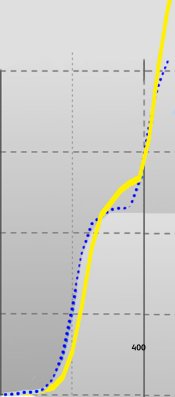Vaughn
Member
Reading some posts on UV light sources and short exposure times people are getting LEDs got me thinking. I have heard, and found thru experience, that longer exposure times for process that are self-masking can yield prints of smoother tonality than the same amount of exposure over a very short period of time.
As I understand it, the visual image forms during exposure proportionally affects the exposure -- it forms strongest in areas of high exposure (shadows), and blocks some UV there while the mid-tones and highlights continue on. As the mask continues to form, it starts masking the mid-tones, etc.
I believe the formation of the mask lags behind the actual exposure, and that during short exposures it does not have a chance to fully form and have maximum effect. I also think it is subtle. How short is short -- my guess just a few minutes. Long exposure -- my guess is 15 minutes at least.
Am I full of it? Quite possibly. Has anyone seen a difference between short and long exposures in terms of tonality? Is it significant enough to design ones UV light system around? Am I a complete nut for putting my contact frame under the lights for 3 minutes and then letting it rest for 10 minutes out of the light, then finishing the last 3 minutes of the exposure? This is with 120 negatives. (I thought the prints looked better) Usually I do not worry about it with LF negatives as they need a long exposure time anyway.
As I understand it, the visual image forms during exposure proportionally affects the exposure -- it forms strongest in areas of high exposure (shadows), and blocks some UV there while the mid-tones and highlights continue on. As the mask continues to form, it starts masking the mid-tones, etc.
I believe the formation of the mask lags behind the actual exposure, and that during short exposures it does not have a chance to fully form and have maximum effect. I also think it is subtle. How short is short -- my guess just a few minutes. Long exposure -- my guess is 15 minutes at least.
Am I full of it? Quite possibly. Has anyone seen a difference between short and long exposures in terms of tonality? Is it significant enough to design ones UV light system around? Am I a complete nut for putting my contact frame under the lights for 3 minutes and then letting it rest for 10 minutes out of the light, then finishing the last 3 minutes of the exposure? This is with 120 negatives. (I thought the prints looked better) Usually I do not worry about it with LF negatives as they need a long exposure time anyway.




